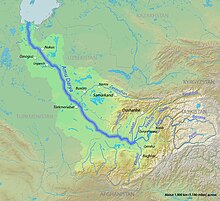Gurgānj Dam

The Gurgānj Dam was a major water engineering project of medieval-era Central Asia. The dam was constructed on the Amu Darya (Oxus) river, near what is now called Konye-Urgench ("Old Gurgānj") in northern Turkmenistan. It was destroyed in 1221 by the troops of Genghis Khan and began to flow into Sarygamysh Lake.[1][2]
History
[edit]The dam stood from about 985 to April 1221, when it was destroyed following the Siege of Gurganj during the Mongol invasion of Khorasan. While it stood, the wickerwork dam was located about a mile upstream from the town.[3][4][page needed] The dam diverted the flow of the previously forked river entirely to the Aral Sea.[5]
Our knowledge of the dam comes from both al-Biruni and Yakut.[6] The dam had gates that controlled the flow of water, much like other dams of the same period throughout Central Asia, such as the one on the Zarafshon river at Afrasiyab.[7] The dam was just one part of the city's waterworks, which included irrigation canals watering expansive agricultural fields.[3][page needed] The irrigation or "trunk" channels went to and throughout the city and agricultural areas. The channels were dug deeper and deeper to reduce the surface area exposed to the sun and lined with clay to avoid seepage.[7]
Destroying the dam washed away the city, the entire metropolitan area, and any surviving residents, which contributed to the overall death toll from the conquest period of the Mongol Empire.[8] The destruction of the dam changed the course of the Oxus towards Sarygamysh Lake; it is believed that this contributed to the recession of the Aral Sea in the medieval period, although this is disputed.[2]
See also
[edit]- Oasis of Bukhara
- Khwarazm – Oasis region in Central Asia
References
[edit]- ^ Islam, S. Nazrul (2020). Rivers and Sustainable Development: Alternative Approaches and Their Implications. Oxford University Press. p. 100. ISBN 978-0-19-007902-4.
- ^ a b Krivonogov, S. K.; Burr, G. S.; Kuzmin, Y. V.; Gusskov, S. A.; Kurmanbaev, R. K.; Kenshinbay, T. I.; Voyakin, D. A. (2014-07-01). "The fluctuating Aral Sea: A multidisciplinary-based history of the last two thousand years". Gondwana Research. 26 (1): 284–300. doi:10.1016/j.gr.2014.02.004. ISSN 1342-937X.
- ^ a b Knobloch, Edgar (2012-05-01). Treasures of the Great Silk Road. The History Press. ISBN 978-0-7524-9792-1.
- ^ Bartolʹd, Vasiliĭ Vladimirovich (1977). Turkestan Down to the Mongol Invasion. E. J. W. Gibb Memorial Trust. ISBN 978-0-87991-453-0.
- ^ Ayni, Sadriddin (2023-09-22). Tajikistan's National Epics: Muqanna's Rebellion and The Tajik People's Hero Temur Malik. Taylor & Francis. ISBN 978-1-000-96328-1.
- ^ Andrianov, Boris V. (2013-12-31). Ancient Irrigation Systems of the Aral Sea Area: The History, Origin, and Development of Irrigated Agriculture. Oxbow Books. ISBN 978-1-78297-165-8.
- ^ a b Starr, S. Frederick (2015-06-02). Lost Enlightenment: Central Asia's Golden Age from the Arab Conquest to Tamerlane. Princeton University Press. p. 38. ISBN 978-0-691-16585-1.
- ^ Tucker, Jonathan (2015-03-12). The Silk Road: Central Asia, Afghanistan and Iran: A Travel Companion. Bloomsbury Publishing. ISBN 978-0-85773-926-1.


 French
French Deutsch
Deutsch